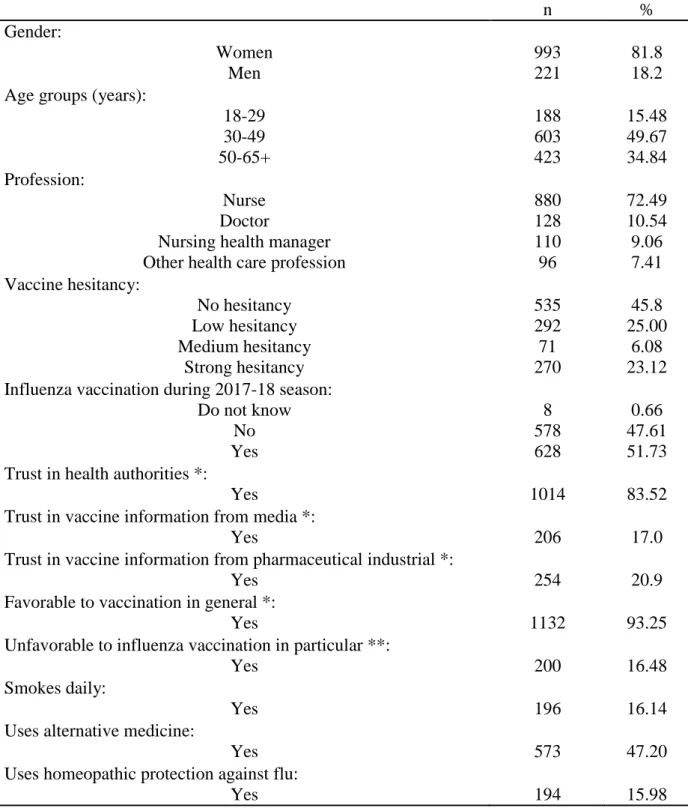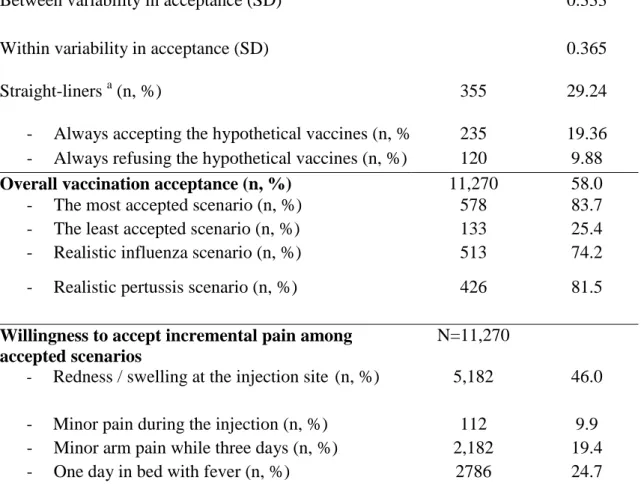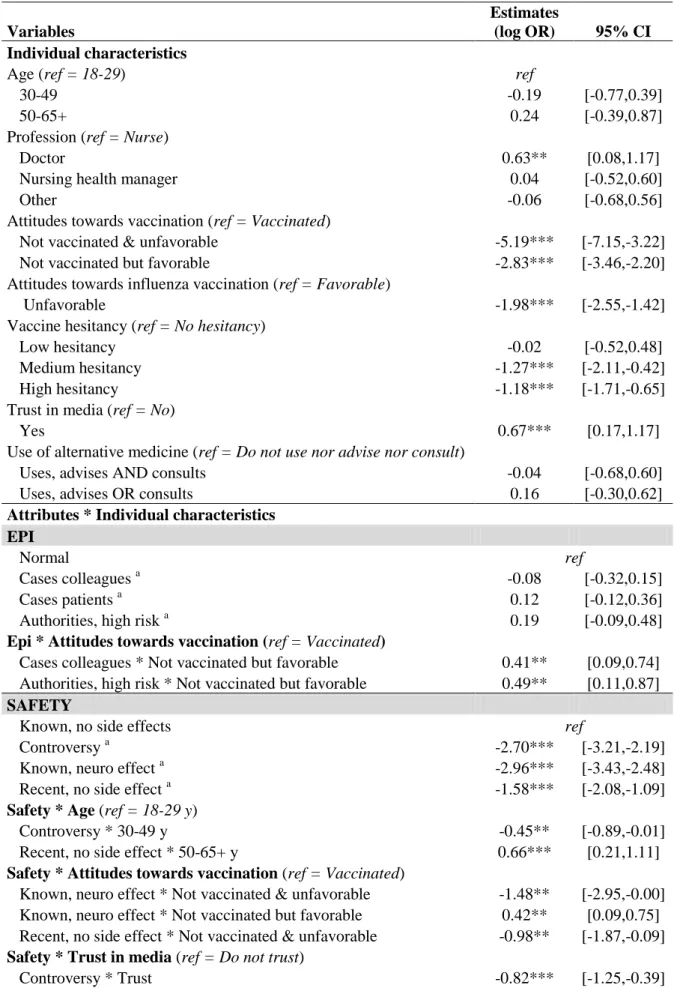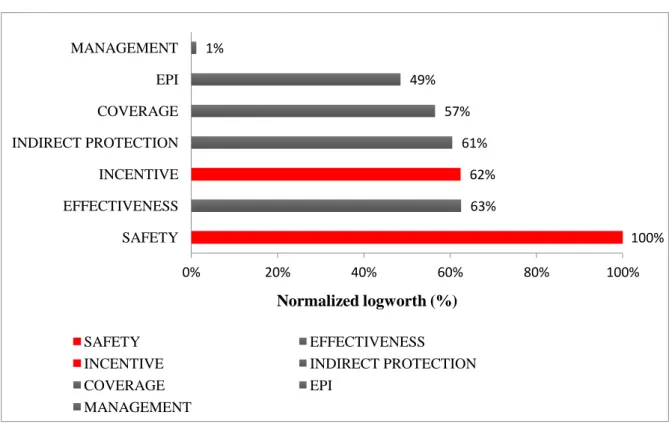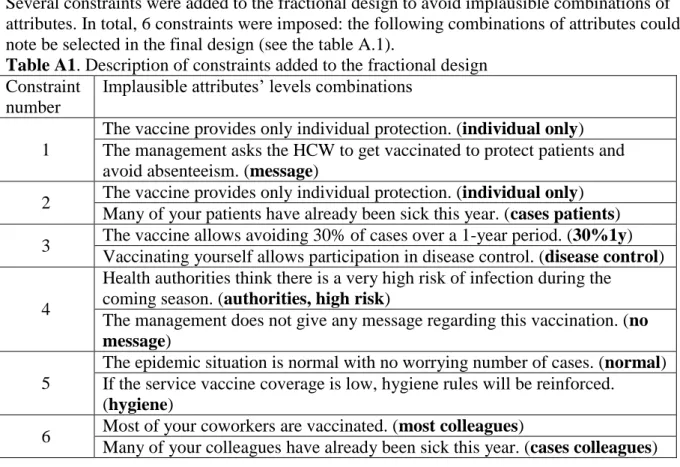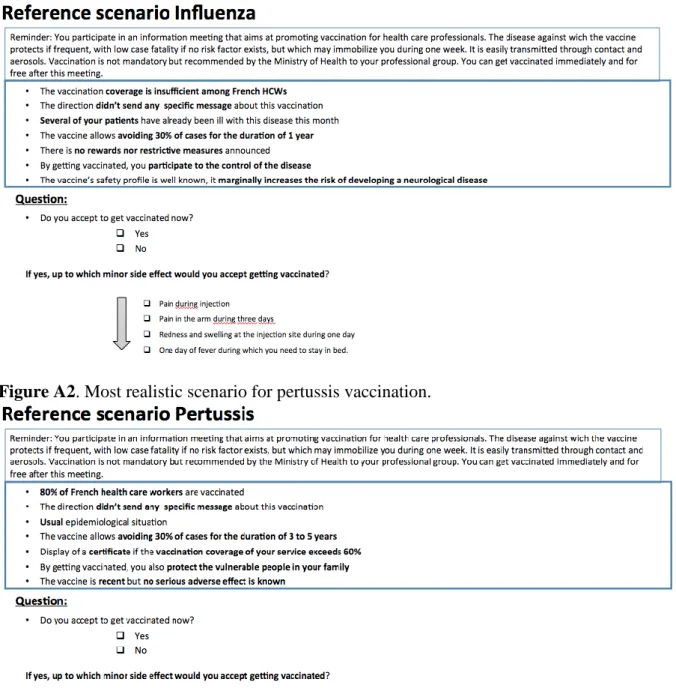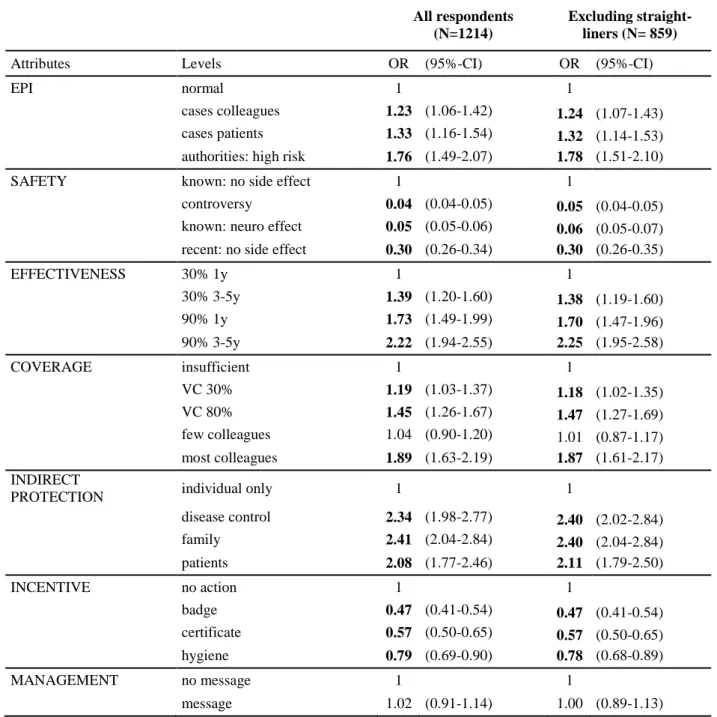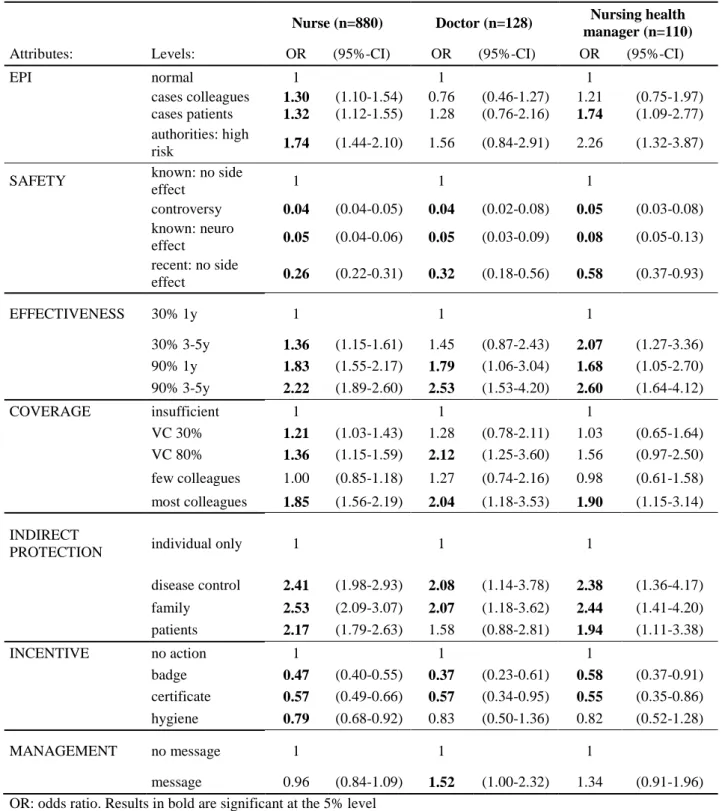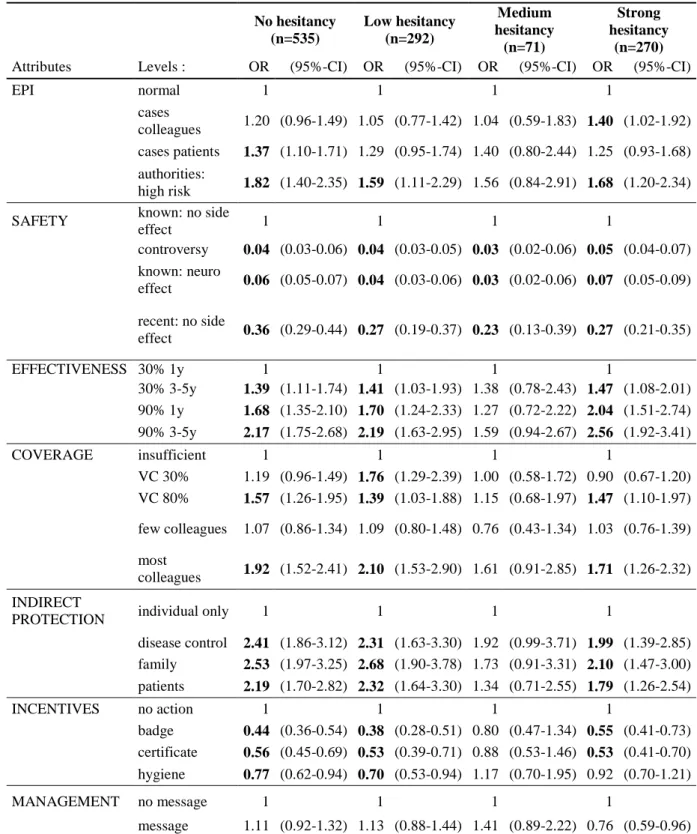HAL Id: halshs-03008549
https://halshs.archives-ouvertes.fr/halshs-03008549
Preprint submitted on 16 Nov 2020
HAL is a multi-disciplinary open access archive for the deposit and dissemination of sci-entific research documents, whether they are pub-lished or not. The documents may come from teaching and research institutions in France or abroad, or from public or private research centers.
L’archive ouverte pluridisciplinaire HAL, est destinée au dépôt et à la diffusion de documents scientifiques de niveau recherche, publiés ou non, émanant des établissements d’enseignement et de recherche français ou étrangers, des laboratoires publics ou privés.
Quantifying preferences around vaccination against
frequent, mild disease with risk for vulnerable persons:
A discrete choice experiment among French hospital
health care workers
Léo Donzel Godinot, Jonathan Sicsic, Marie Lachâtre, Dominique Abiteboul,
Elisabeth Rouveix, Gérard Pélissier, Jocelyn Raude, Judith E. Mueller
To cite this version:
Léo Donzel Godinot, Jonathan Sicsic, Marie Lachâtre, Dominique Abiteboul, Elisabeth Rouveix, et al.. Quantifying preferences around vaccination against frequent, mild disease with risk for vulnerable persons: A discrete choice experiment among French hospital health care workers. 2020. �halshs-03008549�
1
Quantifying preferences around vaccination against frequent, mild disease
2with risk for vulnerable persons: A discrete choice experiment among French
3hospital health care workers
45
Léo Donzel Godinot (1)
6 Jonathan Sicsic* (2) 7 Marie Lachatre (3,4) 8 Elisabeth Bouvet (5) 9 Dominique Abiteboul (3) 10 Elisabeth Rouveix (5) 11 Gerard Pelissier (3) 12 Jocelyn Raude (1,6) 13 Judith E. Mueller (1,7) 14 15
(1) EHESP French School of Public Health, Paris and Rennes, France at the time of writting.
16
Current: CHU de Bordeaux
17
(2) Université de Paris, LIRAES (EA 4470), Paris, France
18
(3) Research Group for the Prevention of Occupational Infections in Healthcare Workers
19
(GERES), Paris, France
20
(4) CIC Cochin-Pasteur 1417, Hôpital Cochin/APHP, Paris, France
21
(5) Haute autorité de santé (HAS), Commission technique des vaccinations (CTV), La Plaine
22
Saint Denis, France
23
(6) Unité des Virus Émergents (UVE: Aix-Marseille Univ – IRD 190 – Inserm 1207 – IHU
24
Méditerranée Infection), Marseille, France
25
(7) Institut Pasteur, Paris, France
26
27 28
* Corresponding author: Jonathan Sicsic
29
Université de Paris, LIRAES (EA 4470), 45 rue des Saints-Pères, 75006 Paris, France
30
Jonathan.sicsic@u-paris.fr
31
32
Keywords: France; Vaccination; Influenza; Pertussis; Health care workers; Stated preferences 34
discrete choice experiment; Incentives; Social conformism
35
36
Abstract 37
The individual determinants of vaccine acceptance among health workers (HCWs) have been
38
described in the literature, but there is little evidence regarding the impact of vaccine
39
characteristics and contextual factors (e.g., incentives, communication) on vaccination
40
intentions. We developed a discrete choice experiment (DCE) to assess the impact of seven
41
attributes on stated vaccination intention against an unnamed disease, described as frequent with
42
rapid clinical evolution and epidemic potential (similar to influenza or pertussis). Attributes
43
evaluated vaccine characteristics (effectiveness, security profile), inter-individual aspects
44
(epidemic risk, controversy, potential for indirect protection, vaccine coverage) and incentives
45
(e.g., badge, hierarchical injunction). A total of 1214 French hospital-based HCWs, recruited
46
among professional organizations, completed the online DCE questionnaire. The relative impact
47
of each attribute was estimated using random effects logit models on the whole sample and
48
among specific subgroups. Overall, 52% of included HCWs were vaccinated against influenza
49
during 2017-18 and the average vaccination acceptance rate across all scenarios was 58%.
50
Except for attitude from the management, all attributes’ levels had significant impact on
51
vaccination decisions. Poor vaccine safety had the most detrimental impact on stated acceptance
52
(OR 0.04 for the level controversy around vaccine safety). The most motivating factor was
53
protection of family (OR 2.41) and contribution to disease control (OR 2.34). Other motivating
54
factors were improved vaccine effectiveness (OR 2.22), high uptake among colleagues (OR
55
1.89) and epidemic risk declared by health authorities (OR 1.76). Social incentives (e.g., a badge
56
I’m vaccinated) were dissuasive (OR 0.47). Compared to HCWs previously vaccinated against
57
influenza, unvaccinated HCWs who were favorable to vaccination in general were most sensitive
58
towards improved vaccine effectiveness. Our study suggests that vaccine safety considerations
dominate vaccine decision-making among French HCWs, while adapted communication on
60
indirect protection and social conformism can contribute to increase vaccination acceptance.
61
62
1. Introduction
63Low uptake of recommended vaccinations is a worldwide problem for public health. Low
64
acceptance or hesitancy by the target population or specific subgroups has been identified a main
65
factor for vaccine refusal (MacDonald and SAGE Working Group on Vaccine Hesitancy, 2015).
66
A substantial body of literature has described the determinants of acceptance (and refusal) of
67
specific vaccinations, including that of health care workers, thus informing on the characteristics
68
of persons accepting vaccination. However, individuals’ positions towards vaccination is now
69
understood as a continuum of vaccination hesitancy, ranging from full refusal to full acceptation,
70
on which individuals can move depending on the type of disease to be prevented, type of
71
vaccine, and several other factors, commonly structured into convenience, complacency and
72
confidence (MacDonald and SAGE Working Group on Vaccine Hesitancy, 2015).
73
Understanding the features of vaccination programs that allow hesitant individuals to move from
74
refusal towards acceptance in specific vaccine decisionsare therefore of utmost importance. So
75
far, few research efforts have focused on this aspect. The perspective in this approach is to move
76
from descriptive towards interventional research, to improve communication, strategies and
77
other elements of vaccination programs.
78
Because there is little variation in public health programs (e.g., vaccination) within
79
populations, it is difficult to infer the drivers of individual decisions using observed choices (i.e.,
80
revealed preferences). Discrete choice experiments (DCEs) have been developed to overcome
81
this limitation (Ryan, 1999). DCEs allow exploring the determinants of individual preferences
82
for different health intervention (e.g., a treatment, a preventative or screening program) in
83
hypothetical settings. The service or intervention in question is described by different
84
characteristics or attributes. The attributes are arranged into multi-attribute alternative options
(e.g., treatments), which are presented in choice sets of two or more options. The DCE task
86
requires individuals to choose their preferred option. Econometric analysis of responses then
87
88
allows quantifying the weights individuals attach to various attributes of the health intervention
89
in order to finally predict their independent impact on decisions. DCEs have increasingly been
90
used for valuing treatments, preventative or screening interventions (Bridges et al., 2011; Clark
91
et al., 2014; Johnson et al., 2014; Ryan and Gerard, 2003). More recently, this approach has also
92
been used to elicit preferences not only for vaccines, but vaccination programs, including
93
programmatic and interindividual factors as attributes (Determann et al., 2016; Seanehia et al.,
94
2017; Verelst et al., 2018). Seanehia et al. (2017) conducted a DCE study among French students
95
and concluded that an explicitly stated potential for indirect protection, and factual information
96
on coverage in the community positively impact theoretical individual vaccine acceptance, while
97
a controversy about potential side effects may have greater negative impact than a confirmed
98
rare severe side effect. Another DCE study among Belgian parents showed that vaccine-related
99
side effects and accessibility (in terms of convenience and reimbursement) were the most
100
influential attributes, followed by vaccine effectiveness and burden of disease (Verelst et al.,
101
2018). Besides, peer influence had a greater influence on vaccine decision than free-riding on
102
herd immunity (Verelst et al., 2018).
103
104
Seasonal influenza is recommended for health care workers (HCWs) in most European
105
countries (Maltezou and Poland, 2014; Mereckiene et al., 2014), to reduce work days lost and to
106
interrupt the viral transmission to vulnerable patients (Hayward et al., 2006). However, influenza
107
vaccine coverage among HCWs in Europe remains in general below 40% (Jorgensen et al.,
108
2018). In France, seasonal influenza vaccination among HCWs was estimated at 25.6% in
2008-109
09 (55.0%, 24.4% and 19.5% among physicians, nurses and nurse assistants, respectively)
110
(Guthmann et al., 2012), but recent estimates suggest an increasing trend in coverage, with
34.8% of HCWs vaccinated in 2018-19 (72,2%, 35,9% and 20,9% among physicians, nurses and
112
nurse assistants, respectively) (Santé Publique France, 2019) Mandatory vaccination has been
113
114
suggested as a solution, following the example of the US hospitals and health care organizations
115
(Greene et al., 2018). A similar situation exists for pertussis (whooping cough) vaccination,
116
which is recommended for HCWs in contact with new-born babies to avoid nosocomial infection
117
(Calugar et al., 2006), but for which coverage remains below the target in France (45% among
118
midwifes, 11% among HCWs in general) (Guthmann et al., 2012).
119
The reasons for vaccination refusal by HCWs have been described as misconceptions
120
about the disease (e.g., influenza) and its vaccine (Boey et al., 2018), the perception of low or
121
inconstant vaccine effectiveness, decisional uncertainty (Visser et al., 2018), vaccine safety and
122
fear of adverse events following vaccination (Dorribo et al., 2015), and the belief that the risk of
123
disease transmission during care activities is low or can be avoided by hygienic measures
124
(Doumont and Libion, 2007; Gil et al., 2006). On the other hand, protection for oneself, the
125
family or patients has been identified as reason for acceptance (Hakim et al., 2011; Valour et al.,
126
2007). However, the relative importance of these factors, and the extent to which motivating
127
factors can compensate for low disease risk and worry about the vaccine safety profile, has not
128
been studied, yet. Moreover, the impact of external incentives on vaccination acceptance has not
129
been evaluated in this context.
130
In the present study, we aimed at evaluating preferences for vaccination program
131
characteristics - beyond vaccine access - among French HCWs practicing in hospitals. In
132
particular, we sought to evaluate communication options around specific program aspects (e.g.,
133
coverage, safety, potential for indirect protection) and the effect of incentives. The hypotheses
134
underlying this study were mainly structured according to the health belief model in vaccination
135
(Paulussen et al., 2006; Rosenstock, 1974), proposing the perceived likelihood and severity of
136
disease, the perceived benefits, risks and costs of vaccination as determinants of vaccine
acceptance. We assumed that disease risk perception and vaccine-related factors (safety and
138
effectiveness) would have the strongest impacts on HCWs’ vaccination decisions, but that inter-
139
140
individual level factors (social conformism, potential for indirect protection) and communication
141
modalities (incentives, injunction) can offset these effects to a substantial extent. We also
142
hypothesized that these impacts may vary across groups defined by health-related behavior,
143
attitudes towards vaccination and towards health authorities.
144
145
2. Methods
1462.1. Study design and participant inclusion 147
We conducted a cross-sectional study among French HCWs using a self-administered
148
online questionnaire containing a single profile discrete choice experiment (DCE). The study
149
invitation was addressed to any HCW practicing in France, including students and HCWs in
150
French oversea departments. Respondents indicating that they worked independently, i.e.,
151
outside the hospital, a nursing home or a comparable institution, received a different version of
152
the questionnaire and were excluded from the present analysis. The invitation was distributed by
153
e-mail to a professional registry (18,120 entries) and to two professional organizations: the
154
Research Group for the Prevention of Occupational Infections in Healthcare Workers (GERES)
155
and the National College of Nurses(approximately 300,000 members in total), without any
156
reminder message. Due to the ‘snowball’ sampling technique (investigators recruited HCWs
157
from their acquaintances) used by one professional organization (the GERES) to reach HCW
158
outside the organization, the number of HCW having received the invitation - and thus the
159
response rate and representativeness - could not be estimated. The National College of Nurses
160
included the invitation inside their monthly newsletter, which was sent to 230,000 French nurses
161
and nursing managers. The e-mail contained some basic information about the study’s objectives
and methods, the anticipated time required for participation (i.e., 15-20 minutes) and a link to the
163
anonymous questionnaire on the Sphinx® online survey platform. No informed consent was
164
165
166
required for this anonymous survey. We obtained approval from a French ethics committee (CPP
167
Sud-Est V). The survey platform was open during June 18 through September 06, 2018.
168
169
The questionnaire contained three parts. The first part asked general background
170
information (e.g., profession and socio-demographic characteristics). The second part contained
171
the DCE tool. The third part collected information on vaccine behaviors and attitudes, including
172
sources of vaccine information, vaccine hesitancy on a four levels scale (Verger, 2017) and
173
health-related behavior (e.g., use of alternative medicine, smoking).
174
175
2.2. Design of the DCE tool 176
Attributes and levels
177
The attributes and levels included in the DCE were identified following a review of the
178
literature on determinants of acceptance and refusal of vaccination among HCWs (Boey et al.,
179
2018; Dorribo et al., 2015; Hakim et al., 2011; Visser et al., 2018), with a focus on influenza and
180
pertussis vaccination, and through discussion between eight experts and stakeholders (social
181
scientist, epidemiologist, professional organizations, and occupational health). Given an
182
abundant (grey) literature including from France, we refrained from additional qualitative work
183
to identify attributes and levels. We established a list of possible attributes and levels and
184
eliminated items stepwise in discussion between co-authors, until consensus on the most
185
important items was reached. We considered essential to include items corresponding to the
186
above-mentioned health belief model, as well as the 3C-concept of vaccine hesitancy
187
(convenience, complacency and confidence) (McDonald et al., 2015), along with social
conformism and indirect protection (Seanehia et al., 2017). Convenience was fixed in the frame,
189
defined as the hypothetical situation of a meeting organized by the occupational health service,
190
with the objective to provide information about the vaccine and to offer immediate free
191
192
vaccination. The targeted vaccine-preventable disease was not named but described according to
193
characteristics of influenza and whooping cough: high incidence and seasonal patterns, easily
194
transmitted during close contacts, with a low risk of complications, except for specific vulnerable
195
groups (infants, elderly, chronic disease patients). A total of seven attributes were included in the
196
hypothetical vaccination scenarios (Table 1).
197
- The attribute EPI (4 levels) referred to the epidemic situation and was designed to test
198
how disease risk perception influenced vaccination acceptance. We assumed that the
199
level “cases among colleagues” would have the highest positive impact on vaccine
200
acceptance. Indeed, disease risk perception is a main reason for vaccination (Setbon and
201
Raude, 2010), and colleagues are the most reliable information and also the most
202
immediate threat.
203
- The SAFETY attribute (4 levels) described various situations of vaccine-related side
204
effects. It was developed to test whether a public controversy or a recent vaccine with
205
uncertain safety profile impacted vaccine acceptance as negatively as a confirmed severe
206
side effect, as already observed among French students (Seanehia et al., 2017).
207
- The attribute EFFECTIVENESS (4 levels) evaluated whether an improved vaccine (90%
208
vaccine effectiveness instead of the regularly observed 30% against influenza (Bonmarin
209
et al., 2015)), and larger intervals (every 3-5 years instead of annual vaccination) could
210
stimulate vaccine acceptance.
211
- The COVERAGE attribute (5 levels) was designed to test the impact of social
212
conformism and free-riding on vaccination acceptance, and whether social conformism
213
was stronger towards colleagues or the general HCW population (Hastings et al., 2004).
The reference level “insufficient coverage” represented a commonly used communication
215
formula, which we hypothesized to have no positive impact on vaccine acceptance,
216
217
218
contrary to factual communication of low coverage (30%) or occasional uptake (“a few
219
colleagues”).
220
- The attribute INDIRECT PROTECTION (4 levels) was designed to assess the extent to
221
which communication on supra-individual benefits from vaccination can improve vaccine
222
acceptance (Shim et al., 2012). Indirect protection conferred by a vaccine leads to the
223
effect of herd protection in the population, meaning that the average disease risk is
224
reduced due to reduced pathogen transmission. The risk reduction or the disease control
225
becomes more important as vaccine coverage increases and eventually can reach the level
226
of herd immunity, at which the pathogen does not circulate and thus the disease is
227
eliminated from the population (Fine et al., 2011). We hypothesized that reference to a
228
collective goal (disease control) not involving personal altruism (protection of family,
229
patients) had the highest positive impact, in line with previous results among French
230
university students (Seanehia et al., 2017).
231
- The attribute INCENTIVES (4 levels) tested whether announced incentives or
232
punishment had any positive impact on vaccine acceptance (Lugo, 2007). We had no a
233
priori assumption, because the effect may depend on the complementarity /
234
substitutability between intrinsic motivation (or altruistic motives) towards vaccination
235
and external incentives (Frey, 1994; Janus, 2010).
236
- The MANAGEMENT attribute (2 levels) tested whether a pro-vaccine message of the
237
hospital management team (chief officer), representing a hierarchical injunction with a
238
health-related utility (avoiding work days lost), had positive impact on vaccine
239
acceptance (Canning et al., 2005; Lugo, 2007).
241
We performed a pilot study by having six health professionals in our environment
242
(one nurse, two physicians, two medical students and one pharmacist) self-administering the
243
244
questionnaire and providing feedback that helped us simplify the introduction text of every
245
scenario, and clarify the formulation of some levels.
246
247
Experimental design
248
This list of attributes would theoretically allow constructing 10,240 hypothetical
249
vaccination profiles (i.e., scenarios with only one vignette) in a full factorial design. We used
250
SAS® software to generate a 32-profile orthogonal design with non-informative priors and
251
allowing estimation of all main effects. We constrained the final design to incorporate two
252
specific attributes’ combinations corresponding to contexts that aimed to closely mimic 1) the
253
influenza vaccination situation and 2) the pertussis vaccination situation (see Figures A1 and
254
A2, supplementary file A). Moreover, several constraints were added to avoid implausible 255
combinations of attributes. These constraints automatically generated some correlations between
256
attributes, but these correlations were low as the final design was 90.5% D-efficient compared to
257
the best possible orthogonal design (see Table A1 for detailed model constraints). This initial
258
choice set was ‘blocked’ into two versions of the survey each with 16 profiles (the ‘blocking’
259
procedure allowing minimizing the correlation between the attributes in each version) (Reed
260
Johnson et al., 2013).
261
In each choice task, we presented one hypothetical vaccination profile to participants and
262
asked whether or not they would accept immediate vaccination (single profile DCE format, see
263
Figure 1 for an example choice task). In the vaccination context, individuals are used to make
264
binary choices such as to vaccine or not to vaccine, rather than choosing between several
265
alternative vaccines. We hypothesized that a single profile choice design would increase the
realism of the choice task and thus survey engagement, such that any potential loss in statistical
267
efficiency (only one profile per choice task) would be compensated by an increase in data
268
quality.
269
270
If vaccination was accepted, willingness to accept pain associated with vaccination was
271
evaluated by asking for which maximum level of pain the respondent was willing to be
272
vaccinated (Figure 1). Four ordinal levels were presented to respondents: minor pain during the
273
injection; redness / swelling at the injection site for one day; minor arm pain during three days;
274
one day with fever while you need to stay in bed. We included a briefing on how to complete the
275
choice tasks before the beginning of the DCE (see supplementary file B).
276
277
2.3. Statistical analyses 278
We estimated the determinants of vaccination acceptance using a random intercept logit
279
model, detailed in Eq. (1):
280
281
In Eq. (1), is a binary indicator coded 1 if respondent n accepts the hypothetical 282
vaccination profile j; represent the levels of the attributes
283
displayed in scenario j; is a vector of corresponding part-worth utility coefficients for all 284
levels x-y of attribute k; and is a subject-specific random error term, assumed normally
285
distributed and representing respondent’ n propensity to accept / not accept the hypothetical
286
vaccines. Note that the logit specification in equation (1) further assumes that all other
287
unobserved factors and idiosyncrasies influencing follow a type 1 extreme value 288
distribution. Because all respondents (in a same survey block) faced the same vaccination
289
profiles or scenarios (and thus were exposed to the same attributes’ levels combinations), the
explanatory variables were exogenous such that fixed effects and random effects estimators for
291
panel data collapse (Wooldridge, 2002, chapter 10). The random intercept model was estimated
292
by Gauss-Hermite quadrature.
293
294
We computed the overall significance of the attributes using likelihood ratio tests - that is,
295
by considering the difference in models log likelihoods for an attribute (with all its levels) in and
296
out of a model (Lancsar et al., 2007) – and measured the relative importance of the attributes by
297
the logworth statistic, i.e. –log10 ( of the LR test). 298
We explored the impact of individual characteristics on preference weights (observed
299
preference heterogeneity) in several steps. First, we re-estimated Eq. (1) by adding interactions
300
between all attributes’ levels and individual characteristics including background information
301
(e.g., gender, age, profession), attitudes towards vaccination, and vaccine information from
302
media and health authorities (in total: 26 attribute levels * nine personal characteristics = 234
303
interactions tested). Next, we included only the significant interaction effects (at the 5% level) in
304
a joint model. In addition, we assessed the structural differences in preferences using stratified
305
(subgroup) analysis. A significance threshold of 5% was used to assess statistically significant
306
differences.
307
For the ordinal outcome ‘willingness to accept pain’, we used an ordered panel logit
308
model, assuming proportionality of odds between outcome levels. The levels weights were
309
expressed as odds ratios (OR) with 95% confidence intervals.
310 311
3. Results
312 3.1. Descriptive statistics 313A total of 1827 HCW responded to the online survey, of which 18 did not meet the
314
inclusion criteria. One third (N=595, 32.9%) indicated working outside the institutional setting
315
and were thus excluded from the present analysis. Among the remaining 1214 HCWs, 72.5%
were nurses, 10.5% doctors, 9.1% nursing managers and 7.9% other professional groups
317
(including nurse assistants and midwives) (Table 2). Forty percent of respondents were younger
318
than 40 years, 81.8% were female, 51.7% were vaccinated against influenza during the 2017-18
319
320
season (78.1%, 48.0%, 60.9% and 18.4%, respectively, among doctors, nurses, nursing managers
321
and other groups) and 83.6% were up-to-date for pertussis vaccination. Most HCWs (83.5%)
322
declared trusting health authorities for vaccine information, while only 17.0% declared trusting
323
information from the mass media. Most HCWs were favorable towards vaccination in general
324
(93.2%), and 83.5% towards influenza vaccination. A low, medium and high level of vaccine
325
hesitancy was found for 25.0%, 6.1% and 23.1% of participants, respectively. Use of alternative
326
medicine was reported by 47.2%, and daily smoking, by 16.1% of participants. Only 11 (0.91%)
327
participants were students, therefore their responses were not analyzed separately.
328
329
3.2. Stated preferences 330
Overall, the participating HCWs accepted 58.0% of vaccination scenarios (range: 25.4%
331
to 83.6%). Between- and within-individual heterogeneity in vaccination acceptation was of the
332
same magnitude (0.36 and 0.33, respectively) (Table 3). The scenario representing realistic
333
influenza and pertussis vaccination situation was accepted by 74.2% and 81.4% of HCWs,
334
respectively. The most commonly accepted maximal level of mild side effects was one day of
335
redness and swelling at the injection site (46.0%).
336
337
3.2.1. Determinants of vaccine acceptance 338
The overall importance of attributes is displayed in Figure 2. Safety issues had greatest
339
influence on vaccination acceptance (normalized logworth = 100%, reference) while attitude
340
from the management did not have any significant impact. The attributes EFFECTIVENESS,
INCENTIVE, INDIRECT PROTECTION, and COVERAGE had approximately equal influence
342
(normalized logworth= 63%, 62%, 61%, and 57%, respectively).
343
The impact of each attribute’s levels are details in Table 4. The level “epidemic risk
344
estimated by health authorities” had higher effect than “cases among colleagues” (OR= 1.89 vs.
345
346
OR= 1.23, 95% confidence intervals not overlapping). Vaccine acceptance was positively
347
impacted by higher vaccine effectiveness (level “90% for 3-5 y”: OR= 2.22) and, to a lesser
348
extent, by longer duration of protection (“30% for 3-5y”: OR= 1.39). The attribute SAFETY
349
included the levels with the highest absolute impact on vaccination acceptance, which were all
350
negative. The strongest, negative impact (disutility) was observed for controversy (OR= 0.04)
351
and a confirmed severe side effect (OR= 0.05), followed by “recent vaccine, no side effect
352
known” (OR= 0.30). Among inter-individual factors, the communication of “most colleagues
353
vaccinated” and “80% coverage” had positive impacts (OR= 1.89 and OR= 1.45, respectively),
354
and the communication of “30% coverage” had a small positive effect compared to “insufficient
355
coverage” (OR= 1.19). The potential for indirect protection showed the highest positive effects,
356
with OR =2.41 for “protection of family” and OR= 2.34 for “disease control”. Incentives through
357
badge or certificate, and threat had negative impacts (OR= 0.47, OR= 0.57 and OR= 0.79,
358
respectively). A “message from management” was the only attribute level that did not show any
359
significant impact on vaccination acceptance (OR= 1.02). The results were robust to the
360
exclusion of “straight-liners”, that is, those always refusing or accepting the hypothetical
361
vaccines, thus not contributing to the likelihood of the model (supplementary Table C1).
362
363
3.2.2. Analysis of preference heterogeneity: interaction effects and subgroup analyses 364
Results of interaction models (Table 5) and subgroup analyses (supplementary material
365
C, Tables C2 to C9) showed little variation in preferences according to HCW’s background 366
characteristics (e.g., gender, age, profession), but more pronounced differences according to
vaccination attitudes. Preferences were not significantly different across gender and age
368
accounted for only minor differences in preferences. Significant differences were found
369
regarding vaccine effectiveness (lower utility of improved effectiveness among older HCWs)
370
and vaccine safety profile (e.g., lower disutility from a so far safe but recent vaccine among 50-
371
372
65-year-old HCWs) (Table 5). Regarding profession, some differences were found such as a
373
lower negative effect of “recent vaccine, no side effect” among nursing health managers (OR=
374
0.58, 95%-CI [0.37-0.93]; vs. OR= 0.26 [0.22-0.31] among nurses) and a significantly positive
375
impact of “message from the management” among nursing health managers (Table 5) and among
376
doctors (OR= 1.52, 95%-CI [1.00-2.32]; vs. OR=0.96 [0.84-1.09] among nurses, Table C2).
377
HCWs using, advising and / or consulting (for) alternative medicine experienced increased
378
disutility from the levels “controversy” and “known, neuro effect” of the SAFETY attribute
379
(Table 5).
380
Participants vaccinated against seasonal influenza during 2017-18 (N=628), those not
381
vaccinated but favorable in general (N=502), and those not vaccinated and
vaccine-382
unfavorable (N=76) accepted vaccination in 76.5%, 42.8% and 8.3% of scenarios, respectively.
383
These results show strong consistence between revealed preferences (i.e., reported vaccination
384
uptake) and stated preferences (i.e., hypothetical uptake). Not vaccinated and unfavorable
385
participants tended to be younger, with higher prevalence of women and nurse assistants, while
386
doctors, men and older participants were overrepresented in the vaccinated group. Table 5 show
387
that this composite variable combining vaccine attitudes and practices account for largest
388
variations in preferences. Stratified analyses according to this variable are displayed in
389
supplementary Table C9 / Figure C1. Compared to vaccinated participants, those who were not
390
vaccinated but vaccine-favorable were significantly more sensitive to improved and longer
391
vaccine effectiveness (“90% for 3-5y”: OR=2.84 vs. OR=1.59), but experienced less disutility
392
from controversy (OR=0.05 vs. OR=0.03), confirmed side effect (OR=0.07 vs. OR=0.04) and
incentive through badge (OR= 0.54 vs. OR=0.35) (Table C9). By contrast, compared to the
394
unvaccinated but favorable group, participants who were not vaccinated and
vaccine-395
unfavorable showed substantially greater sensitivity to vaccine safety (OR= 0.01 for “confirmed
396
side effects” and OR= 0.12 for “recent vaccine, no side effect”). They tended to be more
397
398
sensitive to the epidemic situation (OR= 4.67 [1.04-20.99] for “cases among patients”) and to
399
social conformism (OR=3.68 [0.87-15.60] for the level “80% of French HCWs vaccinated”), less
400
sensitive to potential for indirect protection for patients and family except for disease control
401
(OR= 2.13 [0.39-11.72]), and experience greater disutility from incentives (OR = 0.27
[0.07-402
1.08] for the level “badge”).
403
404
3.5. Determinants of willingness to accept pain (ordinal outcome) 405
Regarding the ordinal outcome maximal acceptable minor side effect (willingness to
406
accept pain), most attributes’ levels were not significantly associated with vaccination
407
acceptance and the associated OR were in general close to 1 (Table 4). However, significant
408
effects were found for “high epidemic risk” (OR= 1.49), “controversy” (OR= 0.76), “90%
409
effectiveness for 3-5 years” (OR= 1.24), “30% coverage” (OR= 0.82) and “protection of the
410 family” (OR= 1.43). 411 412 413
4. Discussion
4144.1. Summary of results and interpretation 415
We used a DCE to quantify the weights that French HCWs attach to known factors of
416
vaccine decision. For a disease comparable to influenza or pertussis, we found impacts from –
417
listed in decreasing order of importance – issues around vaccine safety (negative), improved
418
vaccine effectiveness, incentives (negative), potential for indirect protection, vaccine coverage,
and information on epidemic risk. Hierarchical injunction had a positive impact only among
420
nursing health managers and doctors. While the average frequency of acceptance substantially
421
varied between subgroups, preference weights were relatively homogeneous. Among HCWs
422
who were not vaccinated against seasonal influenza, those favorable vs. those unfavorable to
423
424
vaccination in general could be distinguished by a preference for higher vaccine effectiveness
425
among the first group vs. a particularly strong sensitivity for safety-related issues among the
426
second group.
427
Our main hypothesis was that disease risks and vaccination safety were the most
428
important predictors of vaccination decisions. Our results confirm this a priori for issues around
429
vaccine safety, with OR well below 0.5 and down to 0.04, which is close to systematic refusal of
430
vaccination. While such a strong impact from a confirmed side effect can easily be understood
431
and confirm previous results in different contexts (Luyten et al., 2019; Verelst et al., 2018), the
432
even more negative impact from a controversy is surprising. It is theoretically possible that
433
participants imagined that the controversy carried on something worse than a marginally
434
increased risk of a lifelong neurological disease, but it is also possible that controversy aversion
435
per se came into play. Controversies have played a crucial role in the public perception of
436
vaccination over the last few decades in France, spanning from vaccines against hepatitis B and
437
pandemic influenza to HPV and more generally vaccines containing aluminium adjuvants. From
438
an economic standpoint, disutility experienced from the absence of reliable and credible
439
information about risk is related to ambiguity aversion (Berger et al., 2013), a concept that has
440
been shown to negatively affect prevention behaviors (Han et al., 2009) or treatment decisions
441
(Berger et al., 2013). Identifying interventions that can moderate this negative impact of
442
controversies should be of high priority for public health. This is a challenge, as simple delivery
443
of counter-information has been found to aggravate vaccine safety concerns (Pluviano et al.,
444
2017). The substantial negative impact from the information that the vaccine is recent (albeit so
far safe) may appear surprising, but corresponds to the ranking between old, well-known and
446
newly recommended vaccines, recently described in France (Humez et al., 2017). As described
447
by Slovic in a seminal paper (Slovic, 1987), tolerance of new hypothetical risks is usually lower
448
than that of old, well-known ones. In addition, lack of trust in health authorities and
449
450
pharmacovigilence, previously described among European healthcare workers (Karafillakis et
451
al., 2016), may contribute to explain the result. Overall, these results reflect an impressively
452
negative perception of uncertainty around safety, which has also been described among French
453
university students (Seanehia et al., 2017). Whether this is a specificity of the French population,
454
as suggested by an international comparison of the consent to the simplistic affirmation
455
“vaccines are safe” (Larson et al., 2016) requires further investigation.
456
The occurrence of disease cases among patients and colleagues, or the estimation of a
457
higher epidemic risk by health authorities had a relatively low impact on vaccination acceptance
458
(OR <2), which may be explained by the fact that the hypothetical disease was presented as mild,
459
with complications being limited to vulnerable persons. However, the announcement of an
460
epidemic risk tended to have strong impact among vaccine-unfavorable participants, suggesting
461
that communication on an exceptional epidemic risk can be an external cue for vaccination,
462
despite hesitancy (Chang, 2016).
463
The third vaccine-related attribute, improved (duration of) vaccine effectiveness, showed
464
a substantial impact (OR> 2) on vaccine acceptance. This factor is often neglected in the debate
465
around vaccine hesitancy among health care workers, although disease risk perception is
466
necessarily modulated by perception of benefits from vaccination (Becker, 1974) and low
467
effectiveness has been described as a barrier to vaccine uptake (Doumont and Libion, 2007;
468
Hakim et al., 2011). Our results suggest that influenza vaccine acceptance among HCWs could
469
increase, once vaccines with an effectiveness that is less impacted by strain variations will be
470
available.
The inter-individual attributes were found to have a substantial impact on HCWs’ vaccine
472
acceptance. The strong impact from a potential indirect protection suggests that such an
473
argument may partially compensate for the low perceived risk related to the disease (Seanehia et
474
al., 2017). Moreover, directly mentioning patients as a group to protect tended to have less
475
476
impact than referring to collective disease control, in particular among vaccine-unfavorable
477
HCWs. While altruism has been described as a motivating factor for vaccination (Prematunge et
478
al., 2012; Shim et al., 2012), it may not be appropriate to request or incite it and the offer to
479
participate in a collective effort of disease control may more easily be heard. Further research is
480
needed regarding the development of targeted communication content about indirect protection.
481
We found that doctors’ relative weight for indirect protection was lower compared to nurses,
482
which may reflect the fact that the reference level “protect one-self” already is a greater
483
motivator in this group.
484
Our results suggest that most participating HCWs might be prone to normative social
485
influence, with the information about colleagues being vaccinated or a high coverage among
486
HCWs motivating vaccination acceptance. A similar impact was observed among French
487
university students (Seanehia et al., 2017). Social conformism is part of heuristics that are
488
increasingly recognized as determinants of health-related decisions (Gigerenzer, 2008). It is
489
important to note that we could not identify any subgroup in which a “high coverage” attribute
490
level had negative impact on acceptance, thus rejecting free-riding motives among HCWs, in line
491
with results found in previous DCEs among US parents (Gidengil et al., 2012), the Belgian
492
general population (Verelst et al., 2018), and South African adult population (Verelst et al.,
493
2019). Social benefits of vaccination were explicitly addressed in our experiment, which –
494
following Betsch et al. (2013) - may have prevented free-riding. Finally, as hypothesized, the
495
commonly used formulation of “insufficient coverage” was the least attractive for hospital
HCWs. This could point to an aversion against an unsuccessful vaccination program
497
(Prematunge et al., 2012).
498
Our study allowed pretesting interventions to increase vaccine acceptance. While a
499
message from the management did not have any impact except among doctors, any form of
500
incentive event had a substantial negative impact on vaccine acceptance (OR <0.6). This sheds
501
502
light on the motivation of care professionals. Protecting the patient is one primary goal of the
503
profession - also referred as an ‘intrinsic motivation’(Deci, 1972) - and any additional incentive
504
suggesting HCW needs to be rewarded for expected behavior may undermine this intrinsic
505
motivation and thus be negatively perceived (Frey, 1994). For instance, a badge that would allow
506
distinguishing oneself from colleagues may be seen as overjustified (Tang and Hall, 1995), under
507
the assumption that intrinsic and/or social motivations towards vaccination prevail initially. In
508
this respect, our results do not support the assumption that external (non-monetary) incentives
509
could complement intrinsic motivation or altruistic motives (Sicsic et al., 2012). Note that we
510
have limited our tool to incentives currently used in France. Others, such as financial incentives,
511
would require additional analysis.
512
The use of an ordinal outcome representing the maximal acceptable minor side effect
513
allowed us some insight into willingness to accept (WTA) pain/discomfort for vaccination, thus
514
reflecting how far different attributes go beyond personal utility. Most attribute levels showed
515
low or no impact on WTA increasing pain, which suggest that they were part of the personal
516
utility function. However, high epidemic risk according to health authorities, controversy,
517
improved vaccine performance, and protection of the family had a significant impact on WTA
518
side effects, thus suggesting that a motivation beyond personal utility may be at play. This refers
519
to the distinction made by A. Sen between sympathy (within personal utility) and commitment
520
(beyond personal utility) and suggests that altruism can partially be captured by
willingness-to-521
pay studies (Shiell and Rush, 2003).
523
4.2. Study limitations 524
Our study has several limitations. First of all, our study sample was not a representative
525
sample of the French hospital HCW population and it is likely that persons with specific
vaccine-526
related characteristics, such as particularly positive or negative opinion on vaccination, were
527
528
overrepresented. For example, physicians and nursing managers, who are more favorable
529
towards vaccination than other professional groups in our sample, were overrepresented.
530
Prevalence estimates from our study (e.g., average stated vaccination intentions) therefore cannot
531
be interpreted as prevalence among French HCWs. A second issue is that we cannot exclude that
532
stated preferences substantially vary across classes of some unobserved variables, implying that
533
our combined estimates would not be valid. If study participation was correlated to these
534
theoretically unobserved variables, the stated preferences could even be substantially over- or
535
underestimated. To explore this risk, we used a wide range of personal characteristics in
536
interaction analyses. We found substantial variation only for a combination of two variables of
537
vaccine status and perception: vaccinated, unvaccinated but favorable and unvaccinated and
538
unfavorable participants (see Table 5, and supplementary Table C9), suggesting that the
539
inclusion of a more representative HCW sample with lower vaccine coverage and less favorable
540
opinion would have led to higher coefficients (in absolute terms) in combined estimates for the
541
attributes “EPI”, “SAFETY”, “INCENTIVE”, and lower coefficients for the attributes
542
“EFFECTIVENESS” and “INDIRECT PROTECTION”. To attenuate the limitation by
non-543
representative sampling, we show in this manuscript the stratified analyses that yielded the most
544
important variation in preferences.
545
Caution is needed in interpreting our results because of the hypothetical nature of the
546
choices. Hypothetical bias is a concern in stated preference surveys when respondents tend either
547
to overestimate the uptake of hypothetical programs and/or the willingness to pay, because they
do not face the opportunity costs directly (Loomis, 2011). We tried to reduce the prevalence of
549
hypothetical bias ex ante by asking respondents to make choices as honestly as possible, as in a
550
real-life situation. Finally, our empirical models did not account for decision heuristics such as
551
attribute non-attendance, where some respondents base their decision considering only a subset
552
of attributes.
553
554
Our experimental design has some limitations. First, we used a main-effects D-efficient
555
design, which is not optimal for estimating non-linear models with random intercept. We have
556
analyzed the properties of our design a posteriori and found that our design was 81% D-efficient
557
compared to the best possible design for a random intercept logit model using our estimated
558
model’ parameters as priors. Thus, the loss in statistical efficiency is reasonable. Second, our
559
experiment was not designed to test interactions effects between attributes. However, we had not
560
a priori assumptions regarding how specific attributes would interact with each other.Estimation
561
of non-linear in attributes utility functions in the context of vaccines should be included in
562
further research. We believe that qualitative work may help defining such interactions a priori.
563
Finally, the number of choices sets presented to each respondent (i.e. 16) was quite high, which
564
could have resulted in respondents’ fatigue. We investigated this effect using heteroskedastic
565
probit models by including the position of the choice task (i.e., early phase: task 1 to 6, middle
566
phase: task 7 to 12, and late phase: task 13 to 16) as determinant of the variance of the error term
567
(Campbell et al., 2015). We did not find any significant impact of the position of the choice task
568
on the scale of utility (results are available upon request), thus rejecting the assumption of
569
fatigue or decrease in survey engagement. This finding is consistent with previous research
570
conducted in various fields of non-market valuation such as transportation / marketing (Hess et
571
al., 2012) and health (Bech et al., 2011), which did not find decreasing trend in response
572
consistency (scale) across choice tasks. Finally, we cannot exclude that a qualitative study prior
573
to tool development would have revealed barriers and levers that drive vaccine decisions
specifically among French HCWs and which have not yet been described in the published 575 literature. 576 577 578 579 580 4.3. Practical Implications 581
Our results have some implications for vaccine communication towards HCWs. How
582
well they can be generalized from France to other countries requires further investigation. A
583
clear recommendation would carry on clear and factual statements about vaccine safety profiles.
584
Explaining drugs safety appears crucial, particularly how international efforts allow quickly
585
knowing the safety profile of a new vaccine. The communication on scientific uncertainty is
586
difficult, but controversy is clearly worse (Betsch et al., 2013; Seanehia et al., 2017).
587
Another recommendation would carry on avoiding the notion of “insufficient coverage”
588
and rather using positive approaches such as storytelling about vaccinated colleagues and
589
providing factual information about low but continuously increasing coverage. Our results
590
suggest that explaining indirect protection and social benefits may in part counterbalance low
591
disease risk perception, while emphasizing participation in disease control may be more effective
592
than requesting altruism.
593
Using incentives such as badges should be avoided in vaccination promotion to HCWs,
594
as it may even have negative impact, in particular among those who usually get vaccinated. By
595
contrast, a clear argumentation and communication on the relatively high impact that can be
596
expected from high coverage given indirect protection - even with vaccines of limited direct
597
effectiveness - may increase motivation for vaccination, in particular among HCWs who are
598
unvaccinated but favorable to vaccination in general.
Finally, in order to improve vaccination among HCWs who are unfavorable towards
600
vaccination, our study suggests that beliefs about the meaning of uncertainty and controversy
601
need to be addressed in priority and further research is required in order to develop appropriate
602
(targeted) communication contents.
603 604 605 606 4.4. Conclusion 607
Using a DCE among French hospital HCWs, we evaluated the relative importance of
608
individual and inter-individual level characteristics of vaccination scenarios against frequent,
609
usually mild disease that can be severe among vulnerable groups, such as influenza and
610
pertussis. We identified the dominant negative impact of controversies and the notion of “recent
611
vaccines”; distinct preferences among HCWs who recently have refused influenza vaccination
612
and according to their general attitude towards vaccination; and a pronounced negative impact
613
from proposing incentives such as wearing badges “I’m vaccinated”. We suggest optimizing the
614
communication on indirect protection by emphasizing disease control rather than altruism and
615
stimulating positive social conformism. These results illustrate that DCE studies for specific
616
vaccine programs and target groups help understanding vaccination decisions in a refined way,
617
particularly by exploring preferences among specific subgroups and by pretesting interventions.
618
619
References
Bech, M., Kjaer, T., Lauridsen, J., 2011. Does the number of choice sets matter? Results from a web survey applying a discrete choice experiment. Health Econ. 20, 273–286.
https://doi.org/10.1002/hec.1587
Becker, M.H., 1974. The Health Belief Model and Sick Role Behavior. Health Educ. Monogr. 2, 409–419. https://doi.org/10.1177/109019817400200407
Berger, L., Bleichrodt, H., Eeckhoudt, L., 2013. Treatment decisions under ambiguity. J. Health Econ. 32, 559–569. https://doi.org/10.1016/j.jhealeco.2013.02.001
Betsch, C., Böhm, R., Korn, L., 2013. Inviting free-riders or appealing to prosocial behavior? game-theoretical reflections on communicating herd immunity in vaccine advocacy. Health Psychol. Off. J. Div. Health Psychol. Am. Psychol. Assoc. 32, 978–985. https://doi.org/10.1037/a0031590
Boey, L., Bral, C., Roelants, M., De Schryver, A., Godderis, L., Hoppenbrouwers, K.,
Vandermeulen, C., 2018. Attitudes, believes, determinants and organisational barriers behind the low seasonal influenza vaccination uptake in healthcare workers - A cross-sectional survey. Vaccine 36, 3351–3358. https://doi.org/10.1016/j.vaccine.2018.04.044 Bonmarin, I., Belchior, E., Lévy-Bruhl, D., 2015. Impact of influenza vaccination on mortality in
the French elderly population during the 2000-2009 period. Vaccine 33, 1099–1101. https://doi.org/10.1016/j.vaccine.2015.01.023
Bridges, J.F.P., Hauber, A.B., Marshall, D., Lloyd, A., Prosser, L.A., Regier, D.A., Johnson, F.R., Mauskopf, J., 2011. Conjoint analysis applications in health--a checklist: a report of the ISPOR Good Research Practices for Conjoint Analysis Task Force. Value Health J. Int. Soc. Pharmacoeconomics Outcomes Res. 14, 403–413.
https://doi.org/10.1016/j.jval.2010.11.013
Calugar, A., Ortega-Sánchez, I.R., Tiwari, T., Oakes, L., Jahre, J.A., Murphy, T.V., 2006. Nosocomial pertussis: costs of an outbreak and benefits of vaccinating health care workers. Clin. Infect. Dis. Off. Publ. Infect. Dis. Soc. Am. 42, 981–988.
https://doi.org/10.1086/500321
Campbell, D., Boeri, M., Doherty, E., George Hutchinson, W., 2015. Learning, fatigue and preference formation in discrete choice experiments. J. Econ. Behav. Organ. 119, 345– 363. https://doi.org/10.1016/j.jebo.2015.08.018
Canning, H.S., Phillips, J., Allsup, S., 2005. Health care worker beliefs about influenza vaccine and reasons for non-vaccination--a cross-sectional survey. J. Clin. Nurs. 14, 922–925. https://doi.org/10.1111/j.1365-2702.2005.01190.x
Chang, C., 2016. Behavioral Recommendations in Health Research News as Cues to Action: Self-Relevancy and Self-Efficacy Processes. J. Health Commun. 21, 954–968. https://doi.org/10.1080/10810730.2016.1204377
Clark, M.D., Determann, D., Petrou, S., Moro, D., Bekker-Grob, E.W. de, 2014. Discrete Choice Experiments in Health Economics: A Review of the Literature. PharmacoEconomics 32, 883–902. https://doi.org/10.1007/s40273-014-0170-x
Deci, E.L., 1972. Intrinsic motivation, extrinsic reinforcement, and inequity. J. Pers. Soc. Psychol. 22, 113–120. https://doi.org/10.1037/h0032355
vaccination programmes during pandemics caused by pathogens transmitted through respiratory droplets - a discrete choice experiment in four European countries, 2013. Euro Surveill. Bull. Eur. Sur Mal. Transm. Eur. Commun. Dis. Bull. 21.
https://doi.org/10.2807/1560-7917.ES.2016.21.22.30247
Dorribo, V., Lazor-Blanchet, C., Hugli, O., Zanetti, G., 2015. Health care workers’ influenza vaccination: motivations and mandatory mask policy. Occup. Med. Oxf. Engl. 65, 739– 745. https://doi.org/10.1093/occmed/kqv116
Doumont, D., Libion, F., 2007. Vaccination contre la grippe auprès des professionnels de santé : tour d’horizon des pays développés, quelles recommandations pour quelle efficacité ? Fine, P., Eames, K., Heymann, D.L., 2011. “Herd immunity”: a rough guide. Clin. Infect. Dis.
Off. Publ. Infect. Dis. Soc. Am. 52, 911–916. https://doi.org/10.1093/cid/cir007 Frey, B.S., 1994. How Intrinsic Motivation is Crowded out and in. Ration. Soc. 6, 334–352.
https://doi.org/10.1177/1043463194006003004
Gidengil, C., Lieu, T.A., Payne, K., Rusinak, D., Messonnier, M., Prosser, L.A., 2012. Parental and societal values for the risks and benefits of childhood combination vaccines. Vaccine 30, 3445–3452. https://doi.org/10.1016/j.vaccine.2012.03.022
Gigerenzer, G., 2008. Why Heuristics Work. Perspect. Psychol. Sci. J. Assoc. Psychol. Sci. 3, 20–29. https://doi.org/10.1111/j.1745-6916.2008.00058.x
Gil, H., Bailly, P., Meaux-Ruault, N., Clement, I., Floret, N., Guiot, A., Manteaux, C., Talon, D., Magy, N., Dupond, J.L., 2006. La vaccination antigrippale du personnel hospitalier. Enquête de prévalence au CHU de Besançon, hiver 2003–2004. Rev. Médecine Interne 27, 5–9. https://doi.org/10.1016/j.revmed.2005.09.007
Greene, M.T., Fowler, K.E., Ratz, D., Krein, S.L., Bradley, S.F., Saint, S., 2018. Changes in Influenza Vaccination Requirements for Health Care Personnel in US Hospitals. JAMA Netw. Open 1, e180143–e180143. https://doi.org/10.1001/jamanetworkopen.2018.0143 Guthmann, J.-P., Fonteneau, L., Ciotti, C., Bouvet, E., Pellissier, G., Lévy-Bruhl, D., Abiteboul,
D., 2012. Vaccination coverage of health care personnel working in health care facilities in France: results of a national survey, 2009. Vaccine 30, 4648–4654.
https://doi.org/10.1016/j.vaccine.2012.04.098
Hakim, H., Gaur, A.H., McCullers, J.A., 2011. Motivating factors for high rates of influenza vaccination among healthcare workers. Vaccine 29, 5963–5969.
https://doi.org/10.1016/j.vaccine.2011.06.041
Han, P.K.J., REEVE, B.B., MOSER, R.P., KLEIN, W.M.P., 2009. Aversion to Ambiguity Regarding Medical Tests and Treatments: Measurement, Prevalence, and Relationship to Sociodemographic Factors. J. Health Commun. 14, 556–572.
https://doi.org/10.1080/10810730903089630
Hastings, G., Stead, M., Webb, J., 2004. Fear appeals in social marketing: Strategic and ethical reasons for concern. Psychol. Mark. 21, 961–986. https://doi.org/10.1002/mar.20043 Hayward, A.C., Harling, R., Wetten, S., Johnson, A.M., Munro, S., Smedley, J., Murad, S.,
Watson, J.M., 2006. Effectiveness of an influenza vaccine programme for care home staff to prevent death, morbidity, and health service use among residents: cluster randomised controlled trial. BMJ 333, 1241.
https://doi.org/10.1136/bmj.39010.581354.55
Hess, S., Hensher, D.A., Daly, A., 2012. Not bored yet – Revisiting respondent fatigue in stated choice experiments. Transp. Res. Part Policy Pract. 46, 626–644.
https://doi.org/10.1016/j.tra.2011.11.008
Humez, M., Le Lay E, Jestin C, Perrey C, 2017. Obligation vaccinale : résultats d’une étude qualitative sur les connaissances et perceptions de la population générale en France. Vaccination des jeunes enfants : des données pour mieux comprendre l’action publique. Bull Epidémiol Hebd Hors-série Vaccination.
Janus, K., 2010. Managing motivation among health care professionals. Adv. Health Care Manag. 9, 47–77. https://doi.org/10.1108/S1474-8231(2010)0000009007
Johnson, P., Bancroft, T., Barron, R., Legg, J., Li, X., Watson, H., Naeim, A., Watkins, A., Marshall, D.A., 2014. Discrete choice experiment to estimate breast cancer patients’ preferences and willingness to pay for prophylactic granulocyte colony-stimulating factors. Value Health J. Int. Soc. Pharmacoeconomics Outcomes Res. 17, 380–389. https://doi.org/10.1016/j.jval.2014.01.002
Jorgensen, P., Mereckiene, J., Cotter, S., Johansen, K., Tsolova, S., Brown, C., 2018. How close are countries of the WHO European Region to achieving the goal of vaccinating 75% of key risk groups against influenza? Results from national surveys on seasonal influenza vaccination programmes, 2008/2009 to 2014/2015. Vaccine 36, 442–452.
https://doi.org/10.1016/j.vaccine.2017.12.019
Karafillakis, E., Dinca, I., Apfel, F., Cecconi, S., Wűrz, A., Takacs, J., Suk, J., Celentano, L.P., Kramarz, P., Larson, H.J., 2016. Vaccine hesitancy among healthcare workers in Europe: A qualitative study. Vaccine 34, 5013–5020.
https://doi.org/10.1016/j.vaccine.2016.08.029
Lancsar, E., Louviere, J., Flynn, T., 2007. Several methods to investigate relative attribute impact in stated preference experiments. Soc. Sci. Med. 64, 1738–1753.
https://doi.org/10.1016/j.socscimed.2006.12.007
Larson, H.J., de Figueiredo, A., Xiahong, Z., Schulz, W.S., Verger, P., Johnston, I.G., Cook, A.R., Jones, N.S., 2016. The State of Vaccine Confidence 2016: Global Insights Through a 67-Country Survey. EBioMedicine 12, 295–301.
https://doi.org/10.1016/j.ebiom.2016.08.042
Loomis, J., 2011. What’s to Know About Hypothetical Bias in Stated Preference Valuation Studies? J. Econ. Surv. 25, 363–370. https://doi.org/10.1111/j.1467-6419.2010.00675.x Lugo, N.R., 2007. Will carrots or sticks raise influenza immunization rates of health care
personnel? Am. J. Infect. Control 35, 1–6. https://doi.org/10.1016/j.ajic.2006.10.004 Luyten, J., Kessels, R., Atkins, K.E., Jit, M., van Hoek, A.J., 2019. Quantifying the public’s view
on social value judgments in vaccine decision-making: A discrete choice experiment. Soc. Sci. Med. 1982 228, 181–193. https://doi.org/10.1016/j.socscimed.2019.03.025 MacDonald, N.E., SAGE Working Group on Vaccine Hesitancy, 2015. Vaccine hesitancy:
Definition, scope and determinants. Vaccine 33, 4161–4164. https://doi.org/10.1016/j.vaccine.2015.04.036
Maltezou, H.C., Poland, G.A., 2014. Vaccination policies for healthcare workers in Europe. Vaccine 32, 4876–4880. https://doi.org/10.1016/j.vaccine.2013.10.046
Mereckiene, J., Cotter, S., Nicoll, A., Lopalco, P., Noori, T., Weber, J., D’Ancona, F., Levy-Bruhl, D., Dematte, L., Giambi, C., Valentiner-Branth, P., Stankiewicz, I., Appelgren, E., O Flanagan, D., VENICE project gatekeepers group, 2014. Seasonal influenza immunisation in Europe. Overview of recommendations and vaccination coverage for three seasons: pre-pandemic (2008/09), pandemic (2009/10) and post-pandemic
(2010/11). Euro Surveill. Bull. Eur. Sur Mal. Transm. Eur. Commun. Dis. Bull. 19, 20780.
Paulussen, T.G.W., Hoekstra, F., Lanting, C.I., Buijs, G.B., Hirasing, R.A., 2006. Determinants of Dutch parents’ decisions to vaccinate their child. Vaccine 24, 644–651.
https://doi.org/10.1016/j.vaccine.2005.08.053
Pluviano, S., Watt, C., Sala, S.D., 2017. Misinformation lingers in memory: Failure of three pro-vaccination strategies. PLOS ONE 12, e0181640.
https://doi.org/10.1371/journal.pone.0181640
Prematunge, C., Corace, K., McCarthy, A., Nair, R.C., Pugsley, R., Garber, G., 2012. Factors influencing pandemic influenza vaccination of healthcare workers--a systematic review. Vaccine 30, 4733–4743. https://doi.org/10.1016/j.vaccine.2012.05.018
Reed Johnson, F., Lancsar, E., Marshall, D., Kilambi, V., Mühlbacher, A., Regier, D.A., Bresnahan, B.W., Kanninen, B., Bridges, J.F.P., 2013. Constructing Experimental Designs for Discrete-Choice Experiments: Report of the ISPOR Conjoint Analysis Experimental Design Good Research Practices Task Force. Value Health 16, 3–13. https://doi.org/10.1016/j.jval.2012.08.2223
Rosenstock, I.M., 1974. The Health Belief Model and Preventive Health Behavior. Health Educ. Monogr. 2, 354–386. https://doi.org/10.1177/109019817400200405
Ryan, M., Gerard, K., 2003. Using discrete choice experiments to value health care programmes: current practice and future research reflections. Appl. Health Econ. Health Policy. 2, 55–64.
Santé Publique France, 2019. Couverture vaccinale antigrippale chez les professionnels de santé. Bulletin de santé publique. Available at
https://www.santepubliquefrance.fr/determinants-de- sante/vaccination/documents/bulletin-national/bulletin-de-sante-publique-vaccination.-octobre-2019. Last accessed 25 November, 2019
Seanehia, J., Treibich, C., Holmberg, C., Müller-Nordhorn, J., Casin, V., Raude, J., Mueller, J.E., 2017. Quantifying population preferences around vaccination against severe but rare diseases: A conjoint analysis among French university students, 2016. Vaccine 35, 2676–2684. https://doi.org/10.1016/j.vaccine.2017.03.086
Setbon, M., Raude, J., 2010. Factors in vaccination intention against the pandemic influenza A/H1N1. Eur. J. Public Health 20, 490–494. https://doi.org/10.1093/eurpub/ckq054 Shiell, A., Rush, B., 2003. Can willingness to pay capture the value of altruism? An exploration
of Sen’s notion of commitment. J. Socio-Econ. 32, 647–660. https://doi.org/10.1016/j.socec.2003.10.003
Shim, E., Chapman, G.B., Townsend, J.P., Galvani, A.P., 2012. The influence of altruism on influenza vaccination decisions. J. R. Soc. Interface 9, 2234–2243.
https://doi.org/10.1098/rsif.2012.0115
Sicsic, J., Le Vaillant, M., Franc, C., 2012. Intrinsic and extrinsic motivations in primary care: an explanatory study among French general practitioners. Health Policy Amst. Neth. 108, 140–148. https://doi.org/10.1016/j.healthpol.2012.08.020
Slovic, P., 1987. Perception of risk. Science 236, 280–285.
Tang, S.-H., Hall, V.C., 1995. The overjustification effect: A meta-analysis. Appl. Cogn. Psychol. 9, 365–404. https://doi.org/10.1002/acp.2350090502
